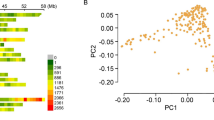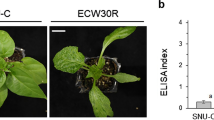Abstract
Abundant anthocyanins accumulate in many flowers, leaves, fruits, as well as stems. In this study, an F2 segregating population derived from a cross between Chinese kale with a purple stem and kale with a green stem was used to decipher the genetic basis for the stem color. Bulked segregant analysis in combination with RNA sequencing (BSR-seq) was used to genetically map the causal gene for the purple stem (Ps), and the allele frequency difference between the two pools showed a single peak on chromosome C09. Ps was fine-mapped to the 0.32 cM interval with 406 kb sequences. A gene-encoding dihydroflavonol 4-reductase (DFR), an enzyme in the anthocyanin biosynthesis pathway, was differentially expressed between the two pools, and was identified as the candidate gene for the purple stem in Chinese kale. Sequence analysis revealed that 1 bp was inserted in the coding sequence of exon 2 of the BoDRF gene in green kale, causing frameshift and loss of function. The expression level of the BoDFR gene was significantly lower than the Chinese kale cultivar with a purple stem. The genetic results of the Ps gene will be useful for future development of purple vegetables.



Similar content being viewed by others
References
Baudry A, Heim MA, Dubreucq B, Caboche M, Weisshaar B, Lepiniec L (2004) TT2, TT8, and TTG1 synergistically specify the expression of BANYULS and proanthocyanidin biosynthesis in Arabidopsis Thaliana. Plant J 39:366–380
Bell G (2010) Fluctuating selection: the perpetual renewal of adaptation in variable environments. Philos Trans R Soc B Biol Sci 365:87–97
Butelli E, Licciardello C, Zhang Y et al (2012) Retrotransposons control fruit-specific, cold-dependent accumulation of Anthocyanins in blood oranges. Plant Cell 24:1242–1255
Chiu LW, Zhou XJ, Burke S, Wu XL, Prior RL, Li L (2010) The purple cauliflower arises from activation of a MYB transcription factor. Plant Physiol 154:1470–1480
Edgar RC (2004) MUSCLE: multiple sequence alignment with high accuracy and high throughput. Nucleic Acids Res 32:1792–1797
Espley RV, Hellens RP, Putterill J, Stevenson DE, Kutty-Amma S, Allan AC (2007) Red colouration in apple fruit is due to the activity of the MYB transcription factor, MdMYB10. Plant J 49:414–427
Feder A, Burger J, Gao S et al (2015) A Kelch domain-containing F-box coding gene negatively regulates Flavonoid accumulation in muskmelon. Plant Physiol 169:1714–1726
Gould KS 2004 Nature’s Swiss army knife: the diverse protective roles of anthocyanins in leaves. J Biomed Biotechnol 2004:314–20
Guo N, Cheng F, Wu J et al (2014) Anthocyanin biosynthetic genes in Brassica Rapa. BMC Genomics 15:426
Holton TA, Cornish EC (1995) Genetics and biochemistry of anthocyanin biosynthesis. Plant Cell 7:1071–1083
Hu DG, Sun CH, Ma QJ, You CX, Cheng L, Hao YJ (2016) MdMYB1 regulates anthocyanin and malate accumulation by directly facilitating their transport into vacuoles in apples. Plant Physiol 170:1315–1330
Huerta-Sanchez E, Durrefft R, Bustamante CD (2008) Population genetics of polymorphism and divergence under fluctuating selection. Genetics 178:325–337
Kim S, Kim CW, Park M, Choi D (2015) Identification of candidate genes associated with fertility restoration of cytoplasmic male-sterility in onion (Allium Cepa L.) using a combination of bulked segregant analysis and RNA-seq. Theor Appl Genet 128:2289–2299
Koes R, Verweij W, Quattrocchio F (2005) Flavonoids: a colorful model for the regulation and evolution of biochemical pathways. Trends Plant Sci 10:236–242
Langmead B, Trapnell C, Pop M, Salzberg SL (2009) Ultrafast and memory-efficient alignment of short DNA sequences to the human genome. Genome Biol 10:R25
Lepiniec L, Debeaujon I, Routaboul JM et al (2006) Genetics and biochemistry of seed flavonoids. Annu Rev Plant Biol 57:405–430
Li H, Handsaker B, Wysoker A et al (2009) The sequence alignment/map format and SAMtools. Bioinformatics 25:2078–2079
Liu S, Yeh CT, Tang HM, Nettleton D, Schnable PS (2012) Gene mapping via bulked segregant RNA-Seq (BSR-Seq). PLoS One 7:e36406
Liu XP, Gao BZ, Han FQ et al (2017) Genetics and fine mapping of a purple leaf gene, BoPr, in ornamental kale (Brassica oleracea L. var. acephala). BMC Genomics 18:230
Michelmore RW, Paran I, Kesseli RV (1991) Identification of markers linked to disease-resistance genes by bulked segregant analysis: a rapid method to detect markers in specific genomic regions by using segregating populations. Proc Natl Acad Sci U S A 88:9828–9832
Neill SO, Gould KS (2003) Anthocyanins in leaves: light attenuators or antioxidants? Functional Plant Biology 30 (8):865
Parkin IA, Koh C, Tang H et al (2014) Transcriptome and methylome profiling reveals relics of genome dominance in the mesopolyploid Brassica Oleracea. Genome Biol 15:R77
Shirley BW, Hanley S, Goodman HM (1992) Effects of ionizing radiation on a plant genome: analysis of two Arabidopsis transparent testa mutations. Plant Cell 4:333–347
Stuurman J, Hoballah ME, Broger L, Moore J, Basten C, Kuhlemeier C (2004) Dissection of floral pollination syndromes in petunia. Genetics 168:1585–1599
Sun B, Fang L, Liu N et al (2011) Studies on main nutritional components of Chinese Kale among different organs. Acta Horticultrae Sinica 3:021
Sweeney MT, Thomson MJ, Pfeil BE, Mccouch S (2006) Caught red-handed: Rc encodes a basic helix-loop-helix protein conditioning red pericarp in rice. Plant Cell 18:283–294
Takagi H, Abe A, Yoshida K et al (2013) QTL-seq: rapid mapping of quantitative trait loci in rice by whole genome resequencing of DNA from two bulked populations. Plant J 74:174–183
Tang HM, Liu SZ, Hill-Skinner S et al (2014) The maize brown midrib2 (bm2) gene encodes a methylenetetrahydrofolate reductase that contributes to lignin accumulation. Plant J 77:380–392
Trapnell C, Roberts A, Goff L et al (2012) Differential gene and transcript expression analysis of RNA-seq experiments with TopHat and cufflinks. Nat Protoc 7:562–578
Udvardi MK, Czechowski T, Scheible WR (2008) Eleven golden rules of quantitative RT-PCR. Plant Cell 20:1736–1737
Van Ooijen, J. JoinMap 4 (2006) Software for the Calculation of Genetic Linkage Maps in Experimental Populations (Kyazma, Wageningen, The Netherlands
Wang W, Huang S, Liu Y et al (2012) Construction and analysis of a high-density genetic linkage map in cabbage (Brassica oleracea L. var. capitata). BMC Genomics 13:523
Webb DM, Knapp SJ (1990) DNA extraction from a previously recalcitrant plant genus. Plant Mol Biol Report 8:180
Xu WJ, Dubos C, Lepiniec L (2015) Transcriptional control of flavonoid biosynthesis by MYB-bHLH-WDR complexes. Trends Plant Sci 20:176–185
Yuan YX, Chiu LW, Li L (2009) Transcriptional regulation of anthocyanin biosynthesis in red cabbage. Planta 230:1141–1153
Yun JM, Afaq F, Khan N, Mukhtar H (2009) Delphinidin, an anthocyanidin in pigmented fruits and vegetables, induces apoptosis and cell cycle arrest in human colon cancer HCT116 cells. Mol Carcinog 48:260–270
Zhang H, Yi HP, Wu MZ et al (2016) Mapping the flavor contributing traits on “Fengwei melon” (Cucumis melo L.) chromosomes using parent Resequencing and super bulked-Segregant analysis. PLoS One 11:e0148150
Zhang Y, Butelli E, Martin C (2014) Engineering anthocyanin biosynthesis in plants. Curr Opin Plant Biol 19:81–90
Funding
This work was supported by the Fundamental Research Funds for the Central Universities [2662015PY084] and [2014PY031] and the National Natural Science Foundation of China [31471162] and [31572131].
Author information
Authors and Affiliations
Contributions
C.Y. designed the experiment. Q.T. and M.T. finished the major experiments. G.A. planted the population, detected the phenotypes and extracted DNA. W.Z. analyzed the BSR-seq. C.Y. wrote the manuscript, with help from J.C.
Corresponding author
Ethics declarations
Competing financial interests
The authors declare no competing financial interests.
Electronic supplementary material
ESM 1
(DOCX 82 kb)
Rights and permissions
About this article
Cite this article
Tang, Q., Tian, M., An, G. et al. Rapid identification of the purple stem (Ps) gene of Chinese kale (Brassica oleracea var. alboglabra) in a segregation distortion population by bulked segregant analysis and RNA sequencing. Mol Breeding 37, 153 (2017). https://doi.org/10.1007/s11032-017-0752-3
Received:
Accepted:
Published:
DOI: https://doi.org/10.1007/s11032-017-0752-3




